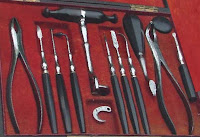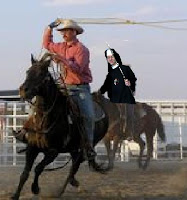 I didn't know Joe back then, but three of my best friends grew up on Hull Street, Rich Bilello, Joe (Lefty) Fierro and Joe Alba. I recently went to Google Maps where, if you key in your old address, it brings up a satellite picture of the house right on the screen. The sight of the old place stirred mixed feelings: on one hand, the exterior looked almost as I remembered it, the two brown brick stoops side by side where we sat and played for hours (my good friend Phil Simeone lived next door); on the other hand it was sad to see what had become of the property over the years. The Weeping Willow tree, under which Phil's grandfather sat every day holding court was gone, the privet hedge in front of my house, out of which I retrieved a thousand Spaldeens that found their way in there while we played stoop ball was gone, but worst of all the place looked so much smaller than when I was a kid.
I didn't know Joe back then, but three of my best friends grew up on Hull Street, Rich Bilello, Joe (Lefty) Fierro and Joe Alba. I recently went to Google Maps where, if you key in your old address, it brings up a satellite picture of the house right on the screen. The sight of the old place stirred mixed feelings: on one hand, the exterior looked almost as I remembered it, the two brown brick stoops side by side where we sat and played for hours (my good friend Phil Simeone lived next door); on the other hand it was sad to see what had become of the property over the years. The Weeping Willow tree, under which Phil's grandfather sat every day holding court was gone, the privet hedge in front of my house, out of which I retrieved a thousand Spaldeens that found their way in there while we played stoop ball was gone, but worst of all the place looked so much smaller than when I was a kid.  I was born on Pacific Street off Rockaway Avenue, over the old Bilello bakery (cousin of Rich's I think) and down the block from Our Lady of Loretto church. When I was two, we moved to Somers Street, a pleasant block of row houses, not the elegant brownstones found in some Brooklyn neighborhoods, but solid, respectable brick homes. I don't know how my parents could even afford a house, but somehow they managed, probably with help from my father's mother, Lucia. The deal was a costly one for our family though, because it meant that Grandma would be living with us. I won't elaborate on Grandma Lucia (may she rest in peace). All I'll say is that she was the antithesis of the stereotypical loving Italian grandmother, and she went out of her way to make my poor mother's life miserable.
I was born on Pacific Street off Rockaway Avenue, over the old Bilello bakery (cousin of Rich's I think) and down the block from Our Lady of Loretto church. When I was two, we moved to Somers Street, a pleasant block of row houses, not the elegant brownstones found in some Brooklyn neighborhoods, but solid, respectable brick homes. I don't know how my parents could even afford a house, but somehow they managed, probably with help from my father's mother, Lucia. The deal was a costly one for our family though, because it meant that Grandma would be living with us. I won't elaborate on Grandma Lucia (may she rest in peace). All I'll say is that she was the antithesis of the stereotypical loving Italian grandmother, and she went out of her way to make my poor mother's life miserable. Our house was three storeys tall. On the first floor were the "parlor" or sitting room (with the fake fireplace), kitchen and bath. The second floor had three bedrooms, and a rentable, three-room apartment comprised the third floor. We rented the apartment to my cousin Pete and his wife Leah who had two children, Peter and Mary Ellen. Pete came from the Caruso branch of the family on my father's side. All the Caruso brothers were loud and raucous except Pete. He was the youngest, and somehow, while growing up in that crazy family, turned out to be one of the sweetest, most gentle men I ever knew. Pete would come downstairs and sit with me for hours, drawing pictures of ships like those he served on in the navy.
Our house was three storeys tall. On the first floor were the "parlor" or sitting room (with the fake fireplace), kitchen and bath. The second floor had three bedrooms, and a rentable, three-room apartment comprised the third floor. We rented the apartment to my cousin Pete and his wife Leah who had two children, Peter and Mary Ellen. Pete came from the Caruso branch of the family on my father's side. All the Caruso brothers were loud and raucous except Pete. He was the youngest, and somehow, while growing up in that crazy family, turned out to be one of the sweetest, most gentle men I ever knew. Pete would come downstairs and sit with me for hours, drawing pictures of ships like those he served on in the navy.  We ate all our meals in the kitchen, as there was no formal dining room. Before the miracle of science known as the "Formica table" we sat at a red and white enamel table with fold-down leafs, the ones that sell as antiques today. Mom prepared all our food on a "modern" gas stove; out in the "shed" an unheated room off the kitchen leading to the back yard, sat a cast iron coal stove (another antique) that was no longer used. It must have been there when we bought the house since it would take a Herculean effort to move. As with most Italian families, the kitchen was the center of activity. We nearly always sat down together as a family for dinner, my father usually in a shirt and tie and my mom in a house dress. The psychologists tell us today that this single ritual is among the most important in building a sense of family values. We took it for granted.
We ate all our meals in the kitchen, as there was no formal dining room. Before the miracle of science known as the "Formica table" we sat at a red and white enamel table with fold-down leafs, the ones that sell as antiques today. Mom prepared all our food on a "modern" gas stove; out in the "shed" an unheated room off the kitchen leading to the back yard, sat a cast iron coal stove (another antique) that was no longer used. It must have been there when we bought the house since it would take a Herculean effort to move. As with most Italian families, the kitchen was the center of activity. We nearly always sat down together as a family for dinner, my father usually in a shirt and tie and my mom in a house dress. The psychologists tell us today that this single ritual is among the most important in building a sense of family values. We took it for granted. The bedrooms were pretty spacious, with parquet floors and high ceilings. My room faced the front of the house, and had a big window looking out on the street. In the dog days of summer, I would swing my bed around so that I could sleep with my head practically out the window. This was in the days before air conditioning...hell, when we got a fan I thought we were "movin' on up!" My parent's bedroom was at the rear of the house, with my sister Cathy's room in the middle. The rooms were separated by sliding wooden doors that recessed into the walls. I can remember how safe I felt in that room, listening to The Lone Ranger and The Jack Benny Show on the radio. It was a different time before the world became such a dangerous place to live.
The bedrooms were pretty spacious, with parquet floors and high ceilings. My room faced the front of the house, and had a big window looking out on the street. In the dog days of summer, I would swing my bed around so that I could sleep with my head practically out the window. This was in the days before air conditioning...hell, when we got a fan I thought we were "movin' on up!" My parent's bedroom was at the rear of the house, with my sister Cathy's room in the middle. The rooms were separated by sliding wooden doors that recessed into the walls. I can remember how safe I felt in that room, listening to The Lone Ranger and The Jack Benny Show on the radio. It was a different time before the world became such a dangerous place to live. Probably 90% of our family lived within a two mile radius of our house, the Lagonigros down the block, the Bivonas, Camardis and Carusos all within walking distance. Holidays were times for the clans to gather, for cousins to play together, and for food and laughter. There were hard times too to be sure, but somehow being surrounded by people who cared about you made them a little easier. Mostly, there were good times: Christmas, Thanksgiving, Baptisms, Communions, Confirmations, birthdays, weddings, family picnics, trips to Coney Island, a lifetime of memories centered around a small street in Brooklyn.
Probably 90% of our family lived within a two mile radius of our house, the Lagonigros down the block, the Bivonas, Camardis and Carusos all within walking distance. Holidays were times for the clans to gather, for cousins to play together, and for food and laughter. There were hard times too to be sure, but somehow being surrounded by people who cared about you made them a little easier. Mostly, there were good times: Christmas, Thanksgiving, Baptisms, Communions, Confirmations, birthdays, weddings, family picnics, trips to Coney Island, a lifetime of memories centered around a small street in Brooklyn.Thomas Wolfe said: "You can't go home again." Maybe not physically, as the Google photos of my old house showed me, but there's a different way to make that journey. It's not healthy to live in the past, but it's OK to visit once in a while. Just close your eyes and become ten years old again...home is waiting for you just the way you remembered it.
CLICK ON DATES AT TOP RIGHT TO SEE OTHER “SPALDEEN DREAMS” POSTS.

































